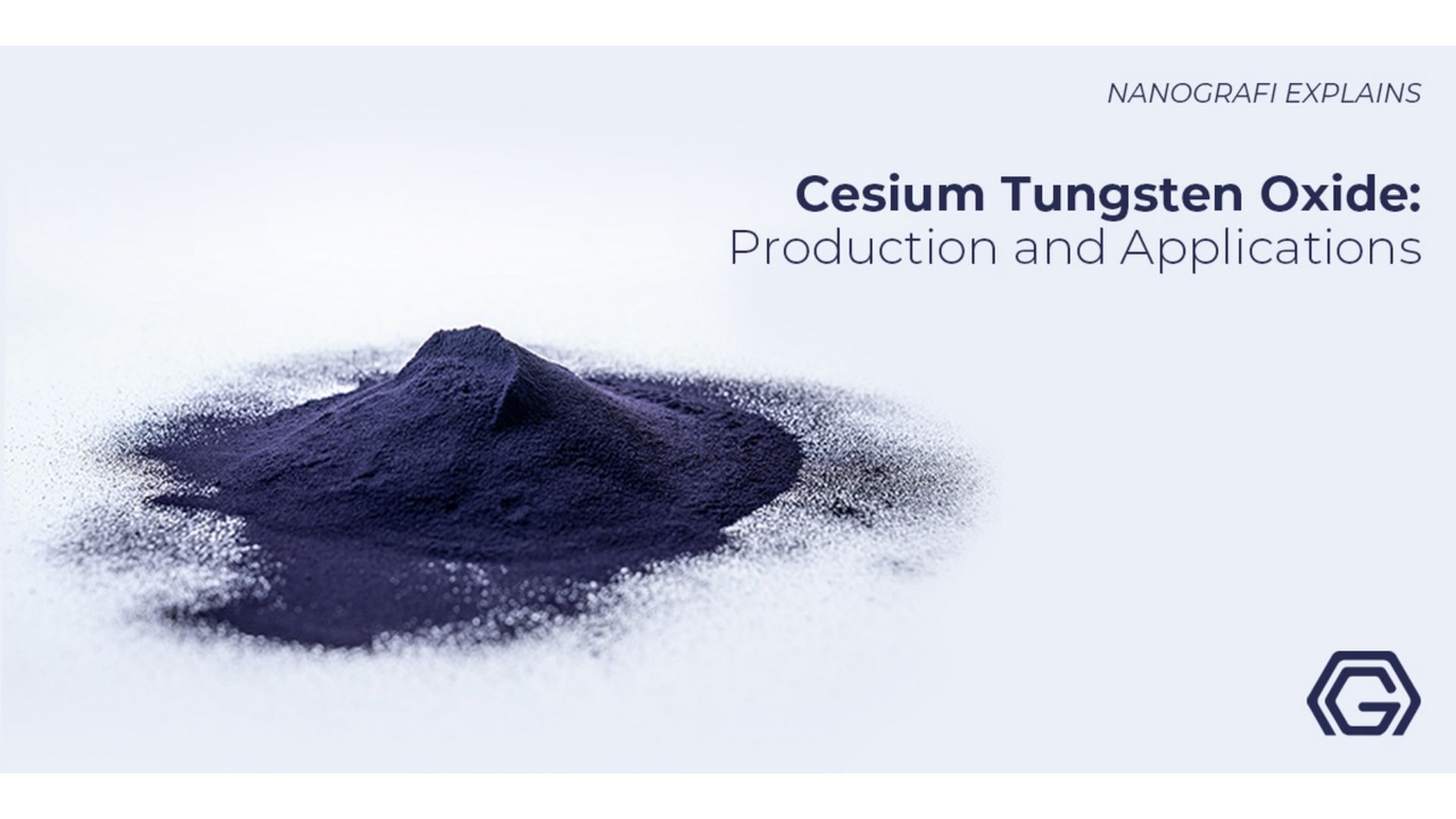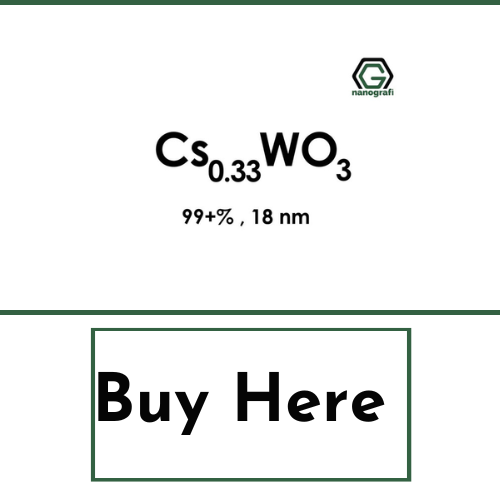Cesium Tungsten Oxide Nanoparticles/Nanopowders and Applications
Cesium tungsten oxide nanoparticles, which are categorized among the plasmonic nanomaterials, have attracted considerable attention as promising near infrared (NIR) shielding material due to their high transmittance of visible light and efficient NIR absorption capability.
Cesium tungsten oxide nanoparticles are also advantageous as pigments with favorable heat resistance and longer lifetime. Nanoscale plasmonic materials exhibit characteristic absorption through surface plasmon excitation.
Vahid Javan Kouzegaran
Analytical Chemist (Ph.D.) / Nanografi Nano Technology
Introduction
In this case, the maximum absorption band wave is strongly sensitive to the morphology, local environment, particle size and coupling of adjacent and close particles. Particularly, cesium doped tungsten oxide nanoparticles possess considerable visible light transparency and have a broad range of absorption from 780 to 2600 nm with the best wavelength blocking between 800 and 1200 nm perfectly applicable to mini LED NIR shielding purposes. Cesium tungsten oxide nanoparticles are originally crystals with no color and strongly hygroscopic and the phase transition in them from orthorhombic to hexagonal system takes place at 536℃.
Physical and Chemical Properties of Cesium Tungsten Oxide Nanoparticles
Cesium tungsten oxide nanoparticles (CTONPs) are capable of converting the absorbed photon energy into heat under optical illumination and can consecutively transmit the heat to the ambient media as fast as a few picoseconds. This property of CTONPs in fast conversion of light to heat has made them a promising nano heaters and potential candidates for relevant applications 1. Theses optical properties are induced by the electrons hybridization on W 5d and O 2p orbital in the conduction band, which are basically derived from vacant orbitals and alkali dopants. Particularly as their electronic property, there exists a coordinated linear structural change in their lattice dimensions known to arise from a distortion called the pseudo-Jahn-Teller (PJT) effect caused by Cesium defection decline along with an increase in vacant orbitals 2. The strong absorption in the near-Infrared region of electromagnetic radiation coming from the free electrons or polsars in cesium tungsten oxide nanoparticles could be an efficient property in NIR photothermal therapy. Nevertheless, it should be noted that there is a report on their application in photothermal therapy and heating the reaction media using NIR photothermal conversion.
Photothermal conversion is a process through which the energy of electromagnetic radiation at a specific wavelength is absorbed and is directly converted to heat. The generated heat can be have applications in in field such as water evaporation, photothermal therapy photo catalysis and in electrochemical devices 3. Photothermal therapy is therapeutic technique through using photosensitizers in order to generate heat from light absorption and kill cancer cells. To do so, the NIR region wavelength is used to avoid healthy cells nonspecific heating and have a deeper penetration into tissues to reach unhealthy cells 4.
Even though tungsten oxide itself has a wide band gap ranging from 2.6 to 3 electron volt and are originally transparent in the visible and NIR, a potent NIR absorption characteristic is possible to be achieved via systematic induction of free electrons into tungsten oxide crystal lattice when ternary elements are added. The nanoscale cesium-doped tungsten oxide crystals also known as tungsten bronze shows better transparency in the NIR region compared to other transparent conductive oxides like antimony doped tin oxide (ATO), translucent deeply colored lanthanum hexaboride (LaB6) and tin doped indium oxide (ITO) which due to localized plarons and surface plasmon resonance of the localized electrons contribution to the NIR absorption of cesium tungsten oxide nanoparticles 5.
To get more information about cesium tungsten oxide,
you can read our blog post here.
Preparation and Synthesis of Cesium Tungsten Oxide Nanoparticles
In the past years, only two efficient methods have been suggested for the synthesis and preparation of NIR shielding cesium tungsten oxide nanoparticles that are known to be high-pressure wet-chemical routes which is carried out both solvothermally and hydrothermally and the other method is solid state reaction. The other methods encompass inductively coupled thermal plasma technology and stirred bead milling process. However, the most common traditional solid state method needs harsh reaction conditions and higher temperatures and the fact is there is no control over the particle size with too many steps that are time consuming and tiring. On the other hand, the low-temperature methods like solvothermal and hydrothermal techniques require a longer synthesis time of around 20 hours to finally obtain the nanoparticles.
In order to overcome the disadvantages mentioned above, a few methods have been developed recently. Among which, a solvothermal method with practically short reaction time has been suggested. A short-time synthesis method requires the use of benzyl alcohol in presence of small quantities of oleic acid which is a fatty acid. Benzyl alcohol has been proven to be as a versatile solvent and reactant to control crystallization and stabilization. Moreover in this method, tungsten chloride (WCl3) is added to the anhydrous benzyl alcohol and dissolved while stirring until a yellowish solution is obtained.Next, cesium hydroxide (CsOH.H2O) is dispersed in benzyl alcohol through sonication. Later, the cesium hydroxide solution is added to solution containing tungsten chloride dropwise to achieve a light brown solution. The solution is stirred to become homogenous for some 20 minutes and oleic acid is added to solution and stirred. Finally, the mixture is poured into a Teflon-lined stainless steel autoclave and heated between 180 to 240 °C for 8 hours. The dark blue precipitate is obtained which is washed four times in ethanol 5.
Another newly developed method suggests cesium tungsten oxide nanoparticles synthesis through stirred bead milling process. Accordingly, microscale coarse powder is ground for 3 hours using beads as small as 50 μm in diameter until the diameter of the hydrodynamic cesium tungsten oxide powder decreases to 50 nm. This can result in a stable aqueous dispersion at pH 8 through a mechanism known to be electrostatic repulsion. The resulting nanoparticles have the hexagonal crystalline structure with favorable photothermal conversion property in NIR region and strong absorption.
Applications of Cesium Tungsten Oxide Nanoparticles
As it has been mentioned earlier, CTONPs are mostly used as near-infrared shielding agents in photothermal therapy. Generally, nanoscale cesium doped tungsten oxide crystals are regarded as favorable agents in solar heat shielding, in biomedical studies an electrochemical devices. Materials that are semiconductor-based absorb light in order to generate electron pairs and based in this, cesium tungsten oxide is an effective agent to be applied for light shielding purposes.
Conclusion
NIR shielding and transparency are important qualities that cesium tungsten nanoparticles are known for and their application in photothermal therapy of cancer cells has shown to be efficient and lifesaver so far. There are few methods for the synthesis of CTONPs and with regard to their viral role in NIR shielding, more and research has to be conducted in order to obtain more homogenous and smaller cesium tungsten oxide crystals.
To get more information, you can visit Blografi.
References
1. Chen, C. J. & Chen, D. H. Preparation and near-infrared photothermal conversion property of cesium tungsten oxide nanoparticles. Nanoscale Res. Lett. 8, 1–8 (2013).
2. Nakakura, S., Arif, A. F., Machida, K., Adachi, K. & Ogi, T. Cationic Defect Engineering for Controlling the Infrared Absorption of Hexagonal Cesium Tungsten Bronze Nanoparticles. Inorg. Chem. 58, 9101–9107 (2019).
3. Wu, C. M., Naseem, S., Chou, M. H., Wang, J. H. & Jian, Y. Q. Recent advances in tungsten-oxide-based materials and their applications. Front. Mater. 6, 1–17 (2019).
4. Chen, C. J. & Chen, D. H. Preparation and near-infrared photothermal conversion property of cesium tungsten oxide nanoparticles. Nanoscale Res. Lett. 8, 1–8 (2013).
5. Eyassu, T., Hsaio, T. J. & Lin, C. T. Facile solvothermal synthesis of NIR absorbing CsxWO3 nanorods by benzyl alcohol route. Mater. Res. Express 2, (2015).
Recent Posts
-
What is the Difference Between 7075 and 6061 Aluminum Alloy?
When comparing 7075 aluminum alloy to 6061 aluminum alloy, it's essential to understand their disti …5th Apr 2024 -
Iron-Air Batteries: The Ultimate Guide
Iron-air batteries represent a significant breakthrough in energy storage technology, offering a sus …29th Mar 2024 -
Discovering the Power of 2D Materials
In material science, the discovery of two-dimensional (2D) materials represents a transformative de …22nd Mar 2024







